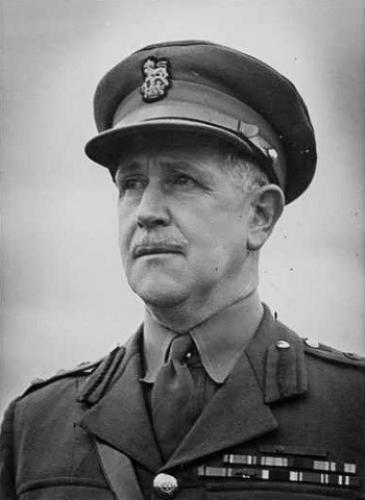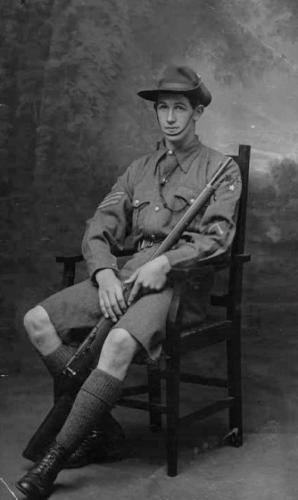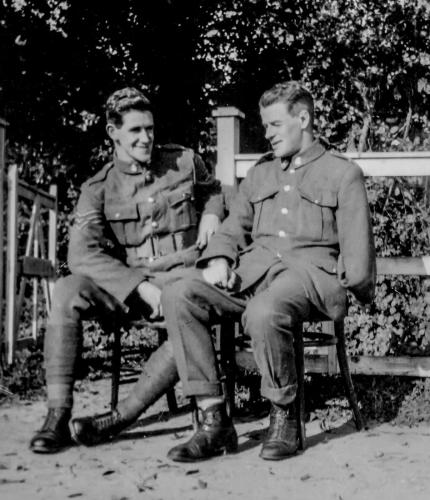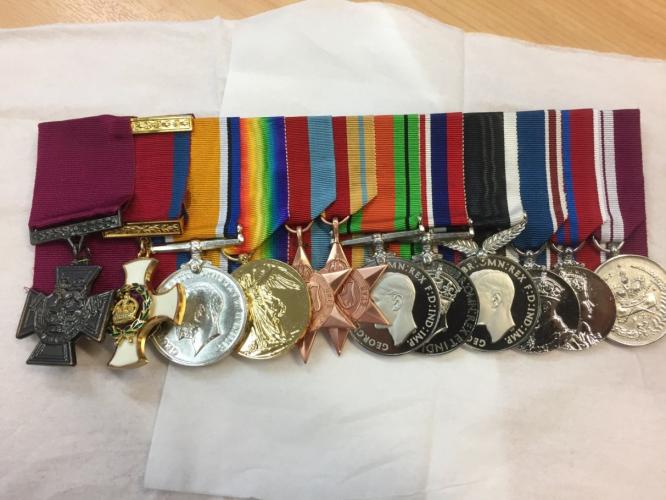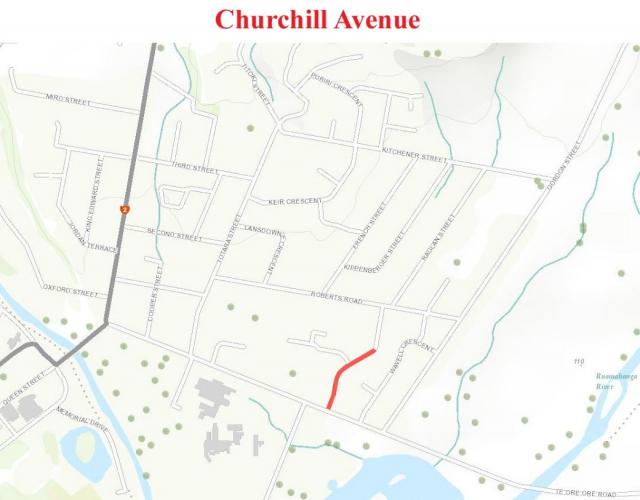113 Andrew Ave Palmerston North, street scene 2017
Reason for the name
This street was named after VC winner Brigadier Leslie Wilton Andrew
The suburb now known as Roslyn was originally part of the suburb of Terrace End. One of the early residents of Terrace End was Mr Charles Ross, a draper, who built a large house in the area. After his death in 1924, his widow sold 20 acres of land to the Government, who promptly named the area Roslyn in honour him. Following the initial state house development of Rangiora Avenue on this land, further sections to the east of the area were sought for redevelopment. This included sections 173 to 179, owned by J D Buchanan, another prominent Palmerston North local, and this land was purchased by the Department of Housing in in November 1944.
A motion at a Council Meeting on 19 August 1946 created a sub-committee for street naming made up of the Mayor, as well as Councillors Hart and Tremaine. On 17 March 1947 this committee recommended that those roads making up the old Buchanan and Main Street blocks were to be named after suggested Victoria Cross recipients. Although the Palmerston North Branch of the Returned Services Association suggested “VC” be added to each street, this was not adopted.
Andrew Avenue is located on the west side of Palmerston North. The street is approximately 600 meters long in an arc running from north starting at Rangiora Avenue and curving west to connect to Vogel Street. Hulme and Elliott, other VC recipient streets, also run off Andrew Avenue. There are 2 moderate sized reserves nearby - Norton Park and Hulme Street Reserve.
Author: Evan Greensides, Heritage Assistant for Palmerston North City Libraries & Community Services.
Leslie Wilton Andrew was born in Ashhurst in March 1897. The eldest son of William and Hannah Andrew, Leslie attended Ashhurst School, Wanganui District School and finally Wanganui Collegiate. At the age of 15 he joined the Avenue School Cadets, reaching the rank of cadet sergeant. After leaving school in 1912, Leslie began work in the office of C.E Mackay, a well-respected local solicitor, afterwards joining New Zealand Railways as a clerk in 1914. Following the general wave of patriotism which swept over New Zealand at the time, Leslie enlisted with many other young men in the Army on 26 October 1915, adding a few years to his real age to ensure acceptance. After basic training he was attached to the Infantry Battalion, 2nd Wellington Regiment.
Leslie left Wellington Harbour bound for Egypt on May 1st 1916 aboard the Ulimaroa. At this time he was part of the 12th Reinforcements, Wellington Infantry Battalion, B Company. Promotion was relatively quick, and after a short time in Egypt he had attained the rank of sergeant. Keen to travel to the Western Front, Leslie voluntarily reverted to private in order to be posted to the 2nd Battalion, whereupon he sailed for England in July later that year.
Leslie joined the New Zealand Expeditionary Force (NZEF) in France in August and was wounded in the neck during action at the Somme in September 1916; the injuries and shrapnel he received to his throat he carried for the rest of his life. Promoted to Corporal in January 1917, Leslie was a little over 20 years old when he found himself in action on the Ypres battlefield, leading to the actions for which he was awarded the Victoria Cross.
On 31 July 1917 at La Basseville, France, two sections from Wellington-West Coast Company under the command of Corporal Leslie Andrew were detailed with the destruction of a machine gun post in the Der Rooster Cabaret which had been holding up the regiment’s advance. Earlier that day Leslie had heard of the death of his best friend, Sandy Weir, spurring him on. Leslie’s citation for the Victoria Cross for his actions that day reads:
Corporal Andrew was in charge of a small party in an attack on the enemy's position. His objective was a machine-gun post which had been located in an isolated building, but on leading his men forward he encountered another machine-gun post which was holding up the advance of another company. He immediately attacked it, capturing the gun and killing several of the crew. He then continued with his attack on the original objective and finally captured the post, killing a number of the enemy and putting the remainder to flight.
These events allowed Ruahine Company to advance into the town, which was then captured. Finally, Leslie learnt that Sandy Weir had not in fact died, but had only lost his left arm, the realisation of which came as a huge relief.
Leslie was promoted to sergeant the day after his momentous actions, followed by a detachment to officer training school in England from which he graduated the following March as a second lieutenant. In November 1917 Leslie Andrew married Bessie Ball, an English woman with whom he was to have five children. In December, Leslie was awarded his Victoria Cross by King George V at Buckingham Palace. He stayed in England until 1919 in which year he had the honour of leading a Victory Day contingent through London, later returning to New Zealand in the regular force. Reverting to his rank of lieutenant after his return he served briefly in Wellington before being posted to the Taranaki Rifles in New Plymouth for the 1st Battalion as an area officer.
Leslie was promoted to captain in 1924, and in 1927 came his next big adventure - secondment for service in India for two years with the Highland Light Infantry and the Kings Scottish Light Infantry on the North West Frontier. On returning to New Zealand he became adjutant of the 1st Wellington Regiment and was staff officer of the New Zealand contingent for the coronation of King George VI in 1937, commanding the New Zealand guard which was mounted at that time at Buckingham and St James’ palaces in London. He was promoted to Major in April 1939 shortly before the outbreak of World War II.
In January 1940 he was promoted to lieutenant colonel and posted to the 2nd New Zealand Expeditionary Force as the first commanding officer of the 22nd Battalion which was then forming at Trentham Military Camp. Leslie soon earned a reputation as a firm and strict, but fair, commanding officer. After his arrival he addressed his very first parade, according to the official history records, “My name is Andrew, A-N-D-R-E-W. There is NO S. And I am the Boss.” Officers were known to leave his midday conferences pale and shaken and his discipline became legendary. The Battalion, which also included Keith Elliot, who would receive his Victoria Cross under Andrew’s command, nicknamed him ‘February’ because he always gave the maximum sentence of 28 days detention for any breaches in discipline. Leslie would also frequently be on the receiving end of General Freyberg’s reprimands during the war for “interpreting orders a little differently”, himself stating that “No right soldier with sensibility for his fellow men would lead them to a slaughter. That might be fine for the British, but not for my men”.
The 22nd Battalion embarked for England in May 1940 as part of 5th Infantry Brigade, 2nd New Zealand Division. Arriving in June, it spent the remainder of the year on garrison duties in the south of England. In March 1941 it travelled for Egypt and then onto Greece, where it saw little action, before evacuating to Crete. It was here that the Battalion was tasked with defending the strategically important Maleme airfield and Hill 107. Forced to disperse his battalions widely to cover his positions, Leslie lost contact with most of his units after German paratroopers began landing in the area on 20 May. Failing to receive any support from his brigade commander and fearing most of his command overrun after a failed counterattack by his small reserve, he withdrew his remaining units, a move which he would be widely criticised of after the war.
Leslie continued to command the 22nd Battalion in the early North African campaign, also taking temporary command of 5 Brigade after Brigadier Hargest was captured, successfully counterattacking a German force at Menastir in December 1941. For his actions he was mentioned in despatches, soon followed by the award of the Distinguished Service Order for his earlier leadership roles. He returned to New Zealand in February 1942 and commanded the Wellington Fortress Area for the remainder of the war. In 1946 Leslie commanded the Victory Contingent to London and attended the Imperial defence College from 1947 to 1948. He was promoted to brigadier in 1948 and later commanded the Central Military District until his retirement in 1952.
Leslie served the New Zealand Defense Force for a total of 37 years and returned to Taranaki, moving home to the Manawatu and then, finally, to Levin in later life. On 8th January1969 Leslie Andrew passed away peacefully at home at the age of 71. He is buried at the Levin RSA cemetery with his wife Bessie. Leslie’s medals, including the Victoria Cross, are housed at the National Army Museum in Waiouru for all of New Zealand to appreciate.
Honours and Awards
- Victoria Cross
- Companion of the Distinguished Service Order (DSO)
- Distinguished Service Order
- British War Medal, 1914-1920
- Victory Medal
- 1939-1945 Star
- Africa Star
- Defence Medal
- War Medal 1939-1945 with oak leaf
- New Zealand War Service Medal
- Coronation Medal, 1937
- Coronation Medal, 1953
- New Zealand Long and Efficient Service Medal
Citation for Victoria Cross:
Corporal Andrew was in charge of a small party in an attack on the enemy's position. His objective was a machine-gun post which had been located in an isolated building, but on leading his men forward he encountered another machine-gun post which was holding up the advance of another company. He immediately attacked it, capturing the gun and killing several of the crew. He then continued with his attack on the original objective and finally captured the post, killing a number of the enemy and putting the remainder to flight.
Citation for Distinguished Service Order:
For outstanding skill and leadership over the very difficult period 25th November to 9th December 1941. The HQ 5th NZ Inf Brigade and attached troops were captured and taken to Bardia on 25th November 1941. This was not known for certain for approximately thirty six hours. Lt Col Andrew's Battalion was then at Menastir and he tried by all means possible to contact his Brigade and other units. However D.R.s failed to return and no contact by wireless could be made. Until 1st December his Battalion continued to carry on their job at Menastir when food and water ran short and ammunition supply was very low. Lt Col Andrew decided the only thing to do was to take his Battalion and join up with the Indian Division near the Omars. So on the night of the 1st December the Battalion formed up on the escarpment, arriving Omars at 0400 hrs and contacted Indian Division who gave Lt Col Andrew orders to proceed to Musaid and form a new Brigade HQ with himself in command and that his Battalion was to strengthen up the line Sollum-Capuzzo. These orders were successfully carried out. On 3rd December the Brigade was ordered to Menastir to occupy the line previously held by 22 Battalion, handing over to the Indians. At Menastir the Brigade defeated several very heavy attacks by Germans, inflicting extremely heavy losses on the enemy. After three days the Brigade was ordered back to take over Sollum-Capuzzo line again. Owing to the position of the enemy this had now become a more difficult move and the only track from below the escarpment was very narrow and blasting by the engineers had been going on for two or three days to make it possible for the transport. However this was successfully accomplished and the Sollum-Capuzzo line taken over again. During this period Lt Col Andrew showed outstanding courage, skill and leadership and owing to his efforts the Brigade was brought through a very difficult fourteen days. He handed over the Brigade on 9th December.


